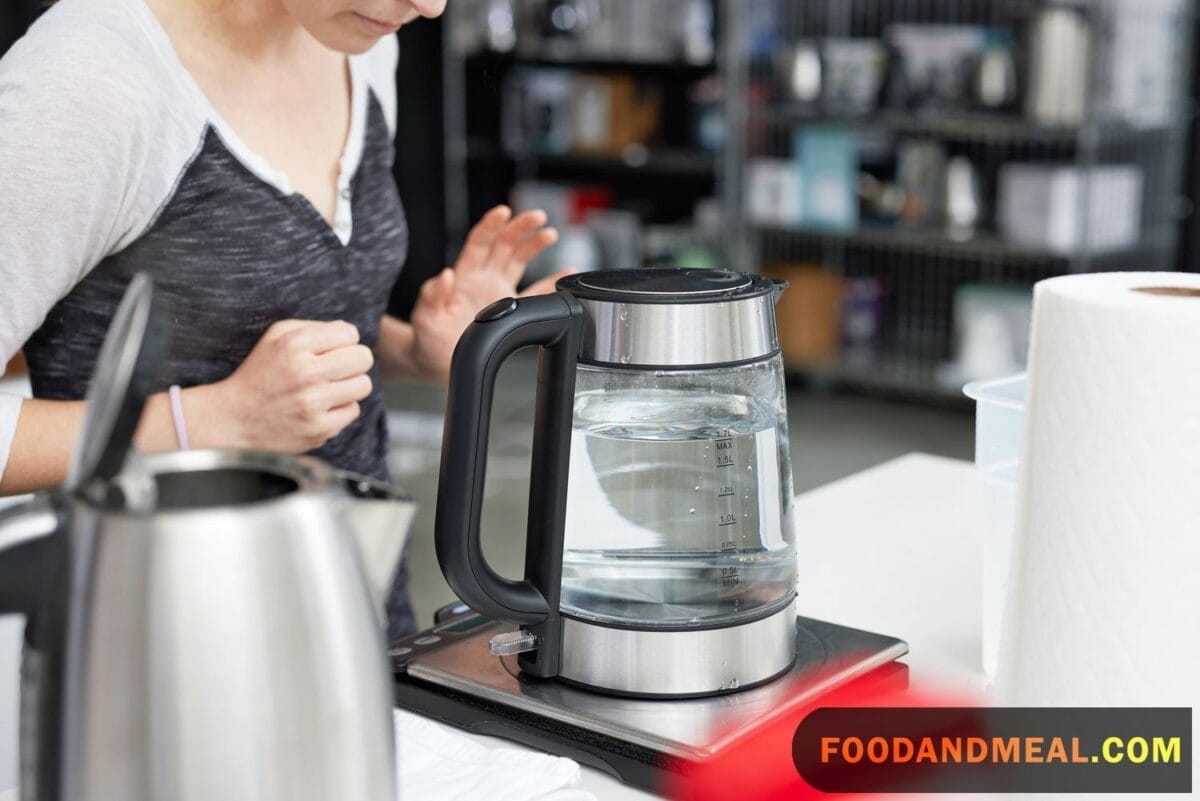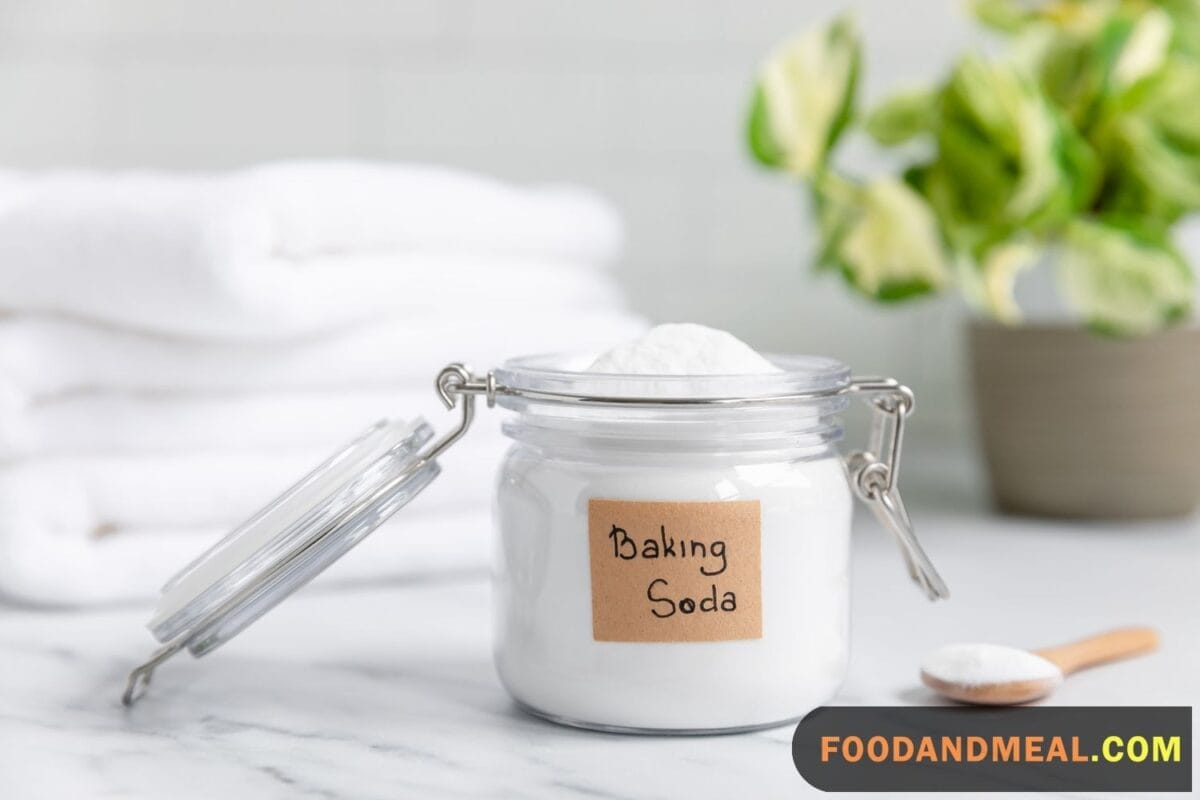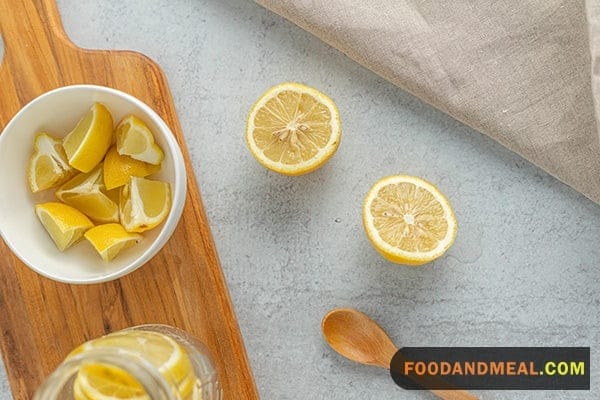Glass kettles, while stylish and eco-friendly, reveal every stain and limescale speck. To help, Food and Meal have crafted a quick guide on How to clean glass tea kettle with natural remedies from your cupboard—no harsh chemicals needed. Let’s get to it!
Why your glass kettle gets so dirty!

In our experience, the glass kettle tends to accumulate dirt and deposits for several reasons, including:
| Hard Water Deposits (Limescale) | One of the common issues we’ve noticed is the impact of hard water, which contains minerals like calcium and magnesium. When heated, these minerals can precipitate out, forming limescale deposits on the interior surfaces of the kettle. |
| Impurities in Water | The water from our taps often contains impurities, sediment, and minerals that settle in the kettle over time, contributing to the gradual buildup of residue. |
| Boiling Water | The process of boiling water itself can lead to the concentration of minerals and impurities. As the water evaporates, it leaves behind these substances on the kettle’s surfaces. |
| Usage Frequency | We’ve observed that the more frequently the kettle is used, the more opportunities there are for deposits to accumulate. Regular use without adequate cleaning can result in a progressively dirtier kettle. |
| Residue from Teas and Infusions | If you frequently use the kettle for brewing teas or infusions, we’ve found that the residue from these beverages can contribute to the buildup of deposits on the kettle’s interior. |
| Quality of Water | We’ve also noticed that the quality of the water used can play a role. Water with higher mineral content tends to result in more significant limescale deposits. |
To keep our glass kettle clean, it’s crucial for us to engage in regular cleaning and descaling routines. This helps maintain the efficiency of the kettle, prevents the development of unwanted odors or tastes in our beverages, and prolongs the overall lifespan of the appliance. Utilizing natural and eco-friendly cleaning methods, such as those involving vinegar or baking soda, has proven effective in tackling limescale and keeping our glass kettle in optimal condition.
Three natural ways to clean a glass kettle
Regularly maintaining your kettle through cleaning is the most effective means of eliminating limescale and preventing its accumulation. Not only does this practice enhance the efficiency of your kettle, thereby saving energy, but it also contributes to prolonging its overall lifespan.
In the realm of energy efficiency, we have curated a dedicated guide to assist you in navigating the selection process when shopping for a kettle that optimizes energy consumption.
For those with glass kettles, discover below the top three methods for cleaning without resorting to harsh chemicals.
A word of caution: avoid the use of standard household descalers in your glass kettle. While there are commendable eco-friendly and refillable descaler formulas available, they are not suitable for kettles and are best reserved for bathroom taps.
Instead, we recommend employing a natural, homemade descaling solution, crafted from ingredients you would readily incorporate into your everyday recipes. This ensures a gentle yet effective approach to maintaining your glass kettle, aligning with both ecological considerations and the principles of a sustainable lifestyle.
The white vinegar method

Employing this approach involves harnessing the acidic properties of vinegar to effectively dislodge and dissolve limescale deposits within your kettle. White vinegar is the preferred choice due to its economic advantages, but for those seeking a distinctive aromatic touch, apple cider vinegar stands as a viable alternative. The use of apple cider vinegar introduces a delightful fragrance that leaves your kettle with a pleasing aroma post-cleaning, creating a more enjoyable and sensory-enhanced experience. Whether you opt for the economical white vinegar or the aromatic apple cider vinegar, both variations offer a natural and efficient means of tackling limescale buildup in your kettle.
Follow these steps:
- Prepare the Vinegar Solution: Begin by measuring ¼ cup of vinegar and pour it into a jug. Top up the jug with water until it reaches a volume sufficient to halfway fill your kettle.
- Thoroughly Mix the Solution: Ensure a well-blended mixture by stirring the solution thoroughly, guaranteeing an even distribution of vinegar and water.
- Pour the Solution into the Kettle and Boil: Carefully pour the prepared vinegar solution into your kettle. Switch on the kettle, allowing it to come to a boil.
- Unplug and Let Sit: Once the boiling process is complete and the kettle automatically switches off, unplug it. Leave the kettle undisturbed for a duration of 20 minutes. This allows the vinegar solution to work effectively on any remaining limescale deposits.
- Gentle Scrubbing (if necessary): If limescale persists after the waiting period, gently scrub the inside of the kettle with a soft brush. This aids in loosening and removing any stubborn deposits.
- Thorough Rinsing: To complete the cleaning process, rinse the kettle thoroughly 2 or 3 times. Ensure that all traces of the vinegar solution are removed, leaving the kettle impeccably clean and free of limescale.
The baking soda method
When employed for cleaning applications, the fine, powdery substance known as baking soda takes on a distinct nomenclature in the UK—bicarbonate of soda—especially in the realm of baking. In essence, this substance is synonymous with pure sodium bicarbonate.
It is crucial to exercise caution and not inadvertently substitute it with British baking powder. Unlike its purer counterpart, British baking powder encompasses bicarbonate of soda alongside supplementary components, including cornflour and additional weak acids. As a consequence, the efficacy of baking powder as a cleaning agent is notably diminished compared to the potent and singular cleaning capabilities inherent in pure bicarbonate of soda. Therefore, for optimal cleaning results, it is advisable to adhere to the use of the unadulterated bicarbonate of soda in cleaning endeavors, ensuring a more potent and efficient outcome.

Follow these steps:
- Measure Bicarbonate of Soda: Determine the appropriate quantity based on your kettle’s size—use 1 tablespoon of bicarbonate of soda for every liter of water, or half a tablespoon if your kettle has a 500ml capacity.
- Create Bicarbonate Solution: Thoroughly mix the measured bicarbonate of soda with water, ensuring a consistent and well-blended solution.
- Pour into Kettle: Pour the bicarbonate solution into your kettle, distributing it evenly.
- Boil the Solution: Switch on the kettle and bring the bicarbonate solution to a boil.
- Unplug and Let Sit: Once boiling is complete, unplug the kettle. Allow the bicarbonate solution to sit undisturbed in the kettle for a specific period—15 minutes.
- Rinse Immediately: Following the designated waiting time, promptly rinse the kettle thoroughly to eliminate any remaining solution or residue.
The lemon juice method
Using lemon juice is a wonderfully aromatic and eco-friendly method to clean your kettle, imparting a delightful lemony fragrance that complements the experience of brewing tea. Interestingly, most descaling solutions incorporate citric acid, the very acid present in lemon slices. While commercial descaling solutions feature a highly concentrated form of citric acid along with additional chemicals, opting for lemon juice offers a gentler and more environmentally conscious approach, especially when cleaning a glass kettle.
To employ this method effectively, start by halving a fresh lemon. Squeeze its juice into a bowl, taking care to remove any seeds. Further enhance the concoction by slicing the lemon peel and pulp, adding them to the bowl. The combination of lemon juice, peel, and pulp will create a powerful yet natural cleaning agent.

- Follow these steps:
1. Cut a lemon in half, squeeze the juice into a bowl, and remove the seeds.
2. Slice the lemon peel and pulp, adding them to the bowl.
3. Combine water with the lemon mixture to halfway fill your kettle.
4. Pour the mixture into your kettle, bring it to a boil, then unplug it and let it cool completely.
5. Gently scrub the interior of your kettle with a soft sponge.
6. Pour out the lemon mixture and rinse thoroughly.
7. Repeat the lemon cleaning method as needed until all limescale is removed.
FAQs
- Question: How can I prevent my glass tea kettle from discoloration? To prevent discoloration of your glass tea kettle, avoid boiling water with high mineral content. Regularly clean the kettle using a descaling solution like white vinegar and water.
- Question: What is the quickest way to clean the exterior of a glass tea kettle? Wipe the exterior with a damp cloth for regular cleaning. For stubborn stains, create a mixture of mild dish soap and water. Avoid abrasive cleaners to prevent scratching the glass.
- Question: Can I use lemon to clean my glass tea kettle? Yes, you can. Boil a mixture of water and lemon slices in the kettle, let it sit for a while, then scrub the interior gently and rinse. This helps remove stains and eliminates odors.
- Question: How do I swiftly clean the interior of the glass tea kettle? For a quick interior clean, use a solution of equal parts water and white vinegar. Let it sit for 15-20 minutes, then rinse thoroughly. Repeat if necessary to remove mineral deposits.
- Question: Is handwashing necessary, or can I use a dishwasher to clean my glass tea kettle? Handwashing is often recommended for glass tea kettles to preserve the glass’s integrity. Check the manufacturer’s instructions, as many are not dishwasher-safe.
In summary, maintaining the cleanliness of your glass kettle is crucial for its performance and durability. The guide provides insights into the causes of limescale buildup and offers eco-friendly cleaning solutions using white vinegar, baking soda, and lemon juice. These methods, detailed with step-by-step instructions, ensure a sustainable and effective cleaning experience.
Regular cleaning is vital to prevent odors, tastes, and overall deterioration. Whether you choose vinegar’s acidity, baking soda’s gentle abrasiveness, or the refreshing scent of lemon juice, each method contributes to a spotless kettle and a more sustainable lifestyle.
Consider exploring energy-efficient kettle options for a greener kitchen. Keeping your glass kettle clean is not just about aesthetics—it’s a commitment to efficiency, sustainability, and a delightful tea-drinking experience. Happy brewing!
I'm Kelly Atkinson, with a passion for dissecting the world of home goods. My reviews stem from thorough testing and a love for sharing detailed insights. Each piece I write offers a glimpse into my explorative journey, aiming to guide readers to informed choices with authenticity and precision, making every review a blend of exploration and expertise.
